Catalog Ads designs: The big cheat sheet for higher performance
September 26, 2024
.jpg)
If you are about to design your Catalog Ads for the first time - or want ideas or inspiration on what to include in your new designs - this is the cheat sheet for you.
We have studied thousands of Catalog Ads designs, across 6.5 billion impressions, to understand how showing different product fields and information influence the performance of designs.
Bookmark this page by pressing ctrl + D / cmd + D, or by clicking the star icon in your URL bar ⭐️.
Here you have the insights in a quick cheat sheet - click to get more details:
The most used product fields in Catalog Ads designs:
The moderately used product fields in Catalog Ads designs:
The rarely used product fields in Catalog Ads designs:
Showing Prices in your Catalog Ads
63% of all advertisers designing their Catalog Ads with Confect show the price of the product.
This is by far the most popular information to add about the product in a design and also one of the most fundamental information needed for customers to make a buying decision.
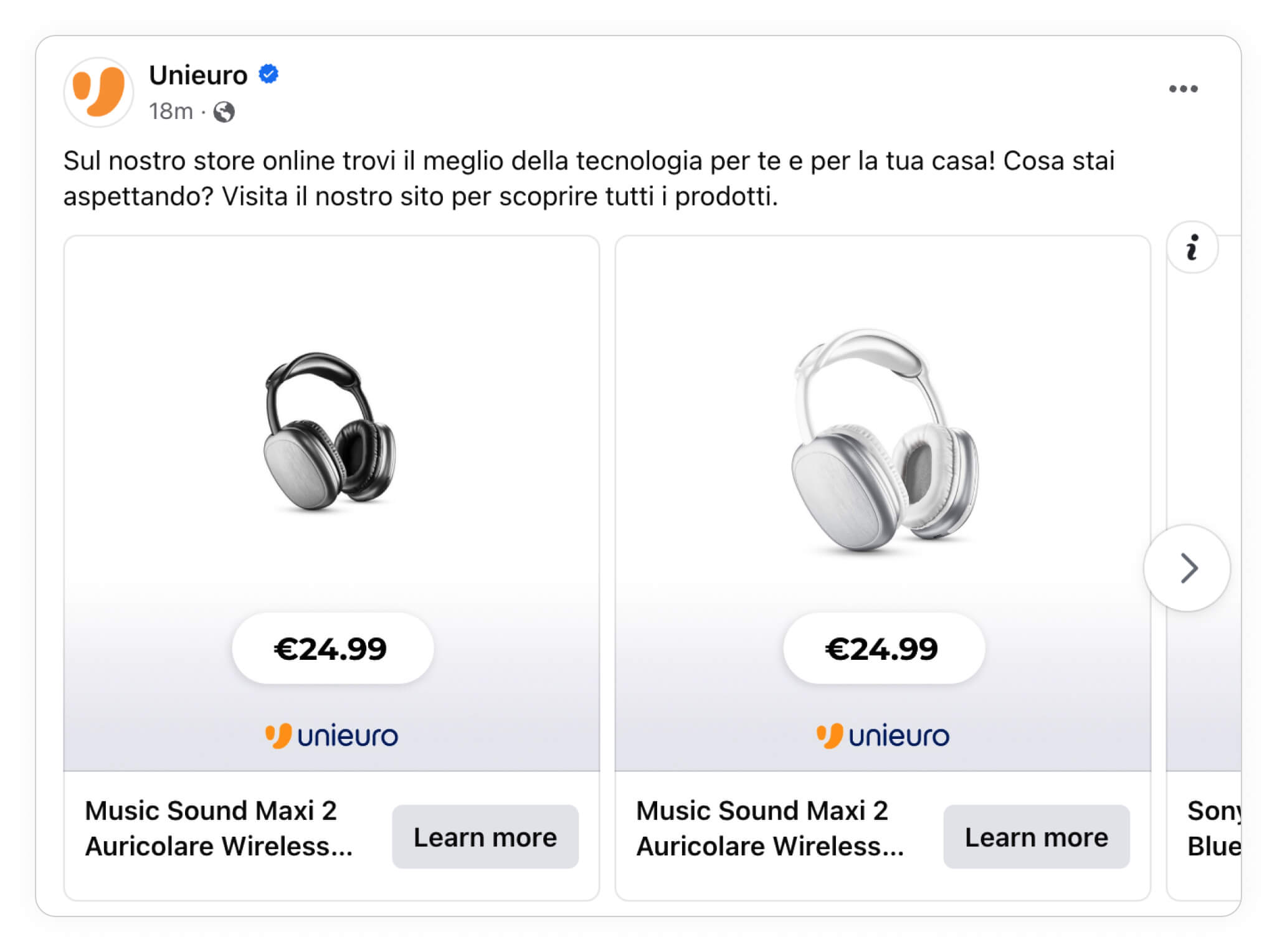
The Catalog Ad above from Unieuro is a good example of highlighting prices very clearly, making sure the customer knows the price.
Here's how showing prices on average influence Catalog Ads:
Return On Ad Spend
+41%
Cost Per Purchase
-2%
Click Through Rate
-16%
Cost Per Click
-5%
Conversion Rate
+10%
Usage
63%
These numbers show how Catalog Ads showing prices perform on average compared to Catalog Ads not showing prices.
Remember that these are average numbers. For some brands, prices perform better, and for other brands, prices perform worse.
The more affordable your products are, the better performance you will typically see showing prices.
- Affordable shops see a +60% improvement in Return on Ad Spend when showing prices
- Mid-end shops see a +43% improvement in Return on Ad Spend when showing prices
- High-end/ Luxury shops see a +35% improvement in Return on Ad Spend when showing prices
Advantages of showing product prices:
- Clear pricing sets expectations for buyers.
- Make it easy to compare products
- Helps attract price-conscious customers.
Disadvantages of showing product prices:
- Could turn away users if prices appear too high.
- May encourage only price-driven customers, reducing brand loyalty.
- Might not be effective for high-end products or brands.
If you’re interested, we have more information and examples on showing prices in your Catalog Ads, plus tips on how to do it with Confect right here.
Even though prices are effective for brands themselves, multi-brand retailers see the biggest improvement in performance when showing prices in their Catalog Ads.
- Brands and DTC companies see a +25% improvement in Return on Ad Spend when showing prices
- Multi-brand stores see a +56% improvement in Return on Ad Spend when showing prices
One last interesting insight about prices: the lower your customer is in your marketing funnel, the better Catalog Ads with prices typically perform compared to Catalog Ads without prices.
- Top-funnel ads see a +31% improvement in Return on Ad Spend when showing prices
- Bottom-funnel ads see a +54% improvement in Return on Ad Spend when showing prices
Showing your Logo in Catalog Ads
54% of all advertisers designing their Catalog Ads with Confect show their own logo.
This is of course smart for longer term branding-reasons, but can also be a bit repetitive when repeated across multiple cards in the same carousel ad.

The Catalog Ad above from ZARA is a good example of utilizing the trust you have as a big brand while building your brand even in your more conversion-focused ads.
Here's how showing your logo on average influence Catalog Ads:
Return On Ad Spend
+7%
Cost Per Purchase
-6%
Click Through Rate
-3%
Cost Per Click
-3%
Conversion Rate
-5%
Usage
54%
These numbers show how Catalog Ads showing the logo of the advertiser perform on average compared to Catalog Ads not showing the logo.
Remember that these are average numbers. For some brands, their logo perform better, and for other brands, their logo perform worse.
Showing your logo in Catalog Ads typically doesn't improve the performance, but we do see some small changes to this based on your audience. The further down in your funnel you are, the more your logo will typically help close the sale.
- Top-funnel ads, on average, don't see improvements in Return on Ad Spend when showing your logo
- Bottom-funnel ads see a +14% improvement in Return on Ad Spend when showing your logo
Advantages of showing your logo:
- Builds brand recognition.
- Highlights well-known brands.
- Ideal for retargeting.
Disadvantages of showing your logo:
- Can distract from the product itself or clutter the design.
- May lower performance for smaller brands.
- Might be repeated multiple times in the same ad.
If you’re interested, we have more information and examples on showing your logo in Catalog Ads, plus tips on how to do it with Confect right here.
Showing On-sale designs in your Catalog Ads
54% of all advertisers designing their Catalog Ads with Confect show some kind of on-sale designs.
This can be designs for products on sale, outlet-products, special promotions, temporary campaigns with discounts, and alike.
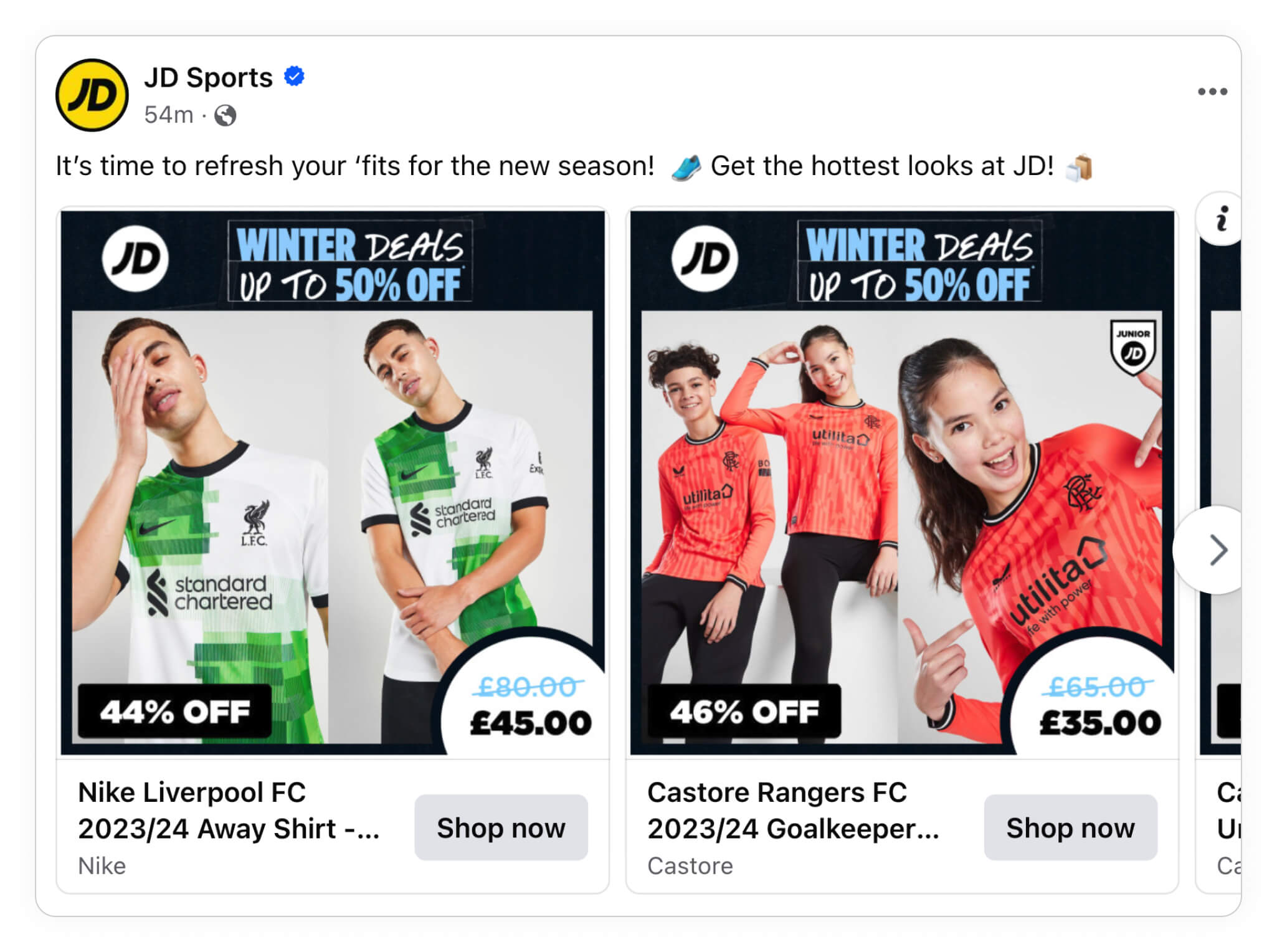
The Catalog Ad above from JD Sports is a good example of a sale - in this case their winter deals - in a very attractive way.
Here's how showing on-sale designs on average influence Catalog Ads:
Return On Ad Spend
+48%
Cost Per Purchase
-22%
Click Through Rate
+2%
Cost Per Click
-26%
Conversion Rate
-11%
Usage
54%
These numbers show how Catalog Ads showing on-sale designs perform on average compared to Catalog Ads not showing on-sale designs.
Remember that these are average numbers. For some brands, on-sale designs perform better, and for other brands, on-sale designs perform worse.
The lower prices you have, the better on-sale designs will typically perform.
- Affordable shops see a +97% improvement in Return on Ad Spend when showing on-sale designs
- Mid-end shops see a +48% improvement in Return on Ad Spend when showing on-sale designs
- High-end/ Luxury shops see a +25% improvement in Return on Ad Spend when showing on-sale designs
You can learn more about showing on-sale designs during campaigns in your Catalog Ads right here and see a lot of sales and campaign Catalog Ad examples here.
Advantages of showing sale-designs:
- Drives conversions with urgency.
- Increases sales volume.
- Ideal for clearing out older inventory.
Disadvantages of showing sale-designs:
- May reduce the perceived value of your brand.
- Can drive customers to look for sales rather than buying at full price.
- Decreases profit margins.
If you’re interested, we have more information and examples on showing sales and campaigns in your Catalog Ads, plus tips on how to do it with Confect right here.
Even though sales more often than not will perform better, then sales are especially effective in your bottom funnel and retargeting - making consumers that already know about you very likely to buy.
The more bottom-funnel your ad is, the better a sale will work.
- Top-funnel ads see a +39% improvement in Return on Ad Spend when showing on-sale designs
- Bottom-funnel ads see a +68% improvement in Return on Ad Spend when showing on-sale designs
Showing Product Names in your Catalog Ads
46% of all advertisers designing their Catalog Ads with Confect show the name of the product.
Product names might be long and detailed, like "Apple iPhone 16 Pro MAX 256GB in black", or short and to the point like "iPhone 16 Pro MAX".

The Catalog Ad above from Argos is a good example of showing product names, making it easy to compare different models of their Nokia phones.
Here's how showing product names on average influence Catalog Ads:
Return On Ad Spend
+22%
Cost Per Purchase
-20%
Click Through Rate
+0%
Cost Per Click
-9%
Conversion Rate
+6%
Usage
46%
These numbers show how Catalog Ads showing product names perform on average compared to Catalog Ads not showing product names.
Remember that these are average numbers. For some brands, product names perform better, and for other brands, product names perform worse.
Showing names and titles of products works best for multi-brand stores, which often sell many more different products compared to the brands themselves.
- Brands and DTC companies see a +11% improvement in Return on Ad Spend when showing product names
- Multi-brand stores see a +31% improvement in Return on Ad Spend when showing product names
You can learn more about showing product names in your Catalog Ads right here.
Advantages of showing product names:
- Helps users recognize the product instantly.
- Builds brand association if the product name is well-known.
- Adds clarity to ads with multiple products.
Disadvantages of showing product names:
- Not impactful if the product name is unfamiliar or a commodity.
- Limited differentiation for products with similar names.
- Distracts from key features like pricing or benefits.
- Overshadows visual aspects of the product.
If you’re interested, we have more information and examples showing product names in your Catalog Ads, plus tips on how to do it with Confect right here.
Showing Original prices in your Catalog Ads
32% of all advertisers designing their Catalog Ads with Confect show the original price of the product.
Original price is hidden if the product is not discounted, and then shown when the product is discounted.
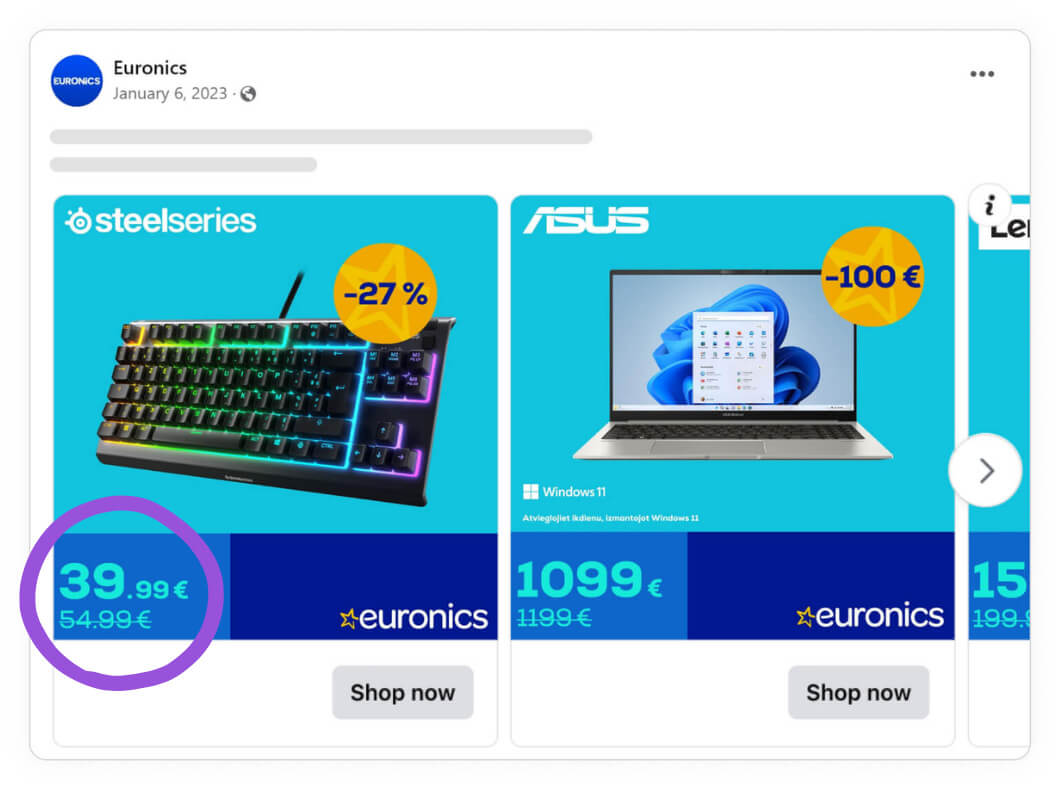
The Catalog Ad above from Euronics is a good example of highlighting original price next to the current sale price, to show how much they save.
Here's how showing original prices on average influence Catalog Ads:
Return On Ad Spend
+30%
Cost Per Purchase
-17%
Click Through Rate
-5%
Cost Per Click
-25%
Conversion Rate
-9%
Usage
32%
These numbers show how Catalog Ads showing original prices perform on average compared to Catalog Ads not showing original prices.
Remember that these are average numbers. For some brands, original prices perform better, and for other brands, original prices perform worse.
Advantages of showing original prices:
- Anchors the sale price to seem very low.
- Encourages purchases by emphasizing the savings.
- Make the product seem like a good deal.
Disadvantages of showing original prices:
- Constant discounting can hurt brand image.
- Can turn away customers if the discount isn’t significant.
- Overshadows product features or quality by focusing on price.
Showing additional images in your Catalog Ads
32% of all advertisers designing their Catalog Ads with Confect show additional images of the product.
This can be done in multiple ways, from showing one very different image compared to the primary one, to showing multiple images showing the same thing from different angles.
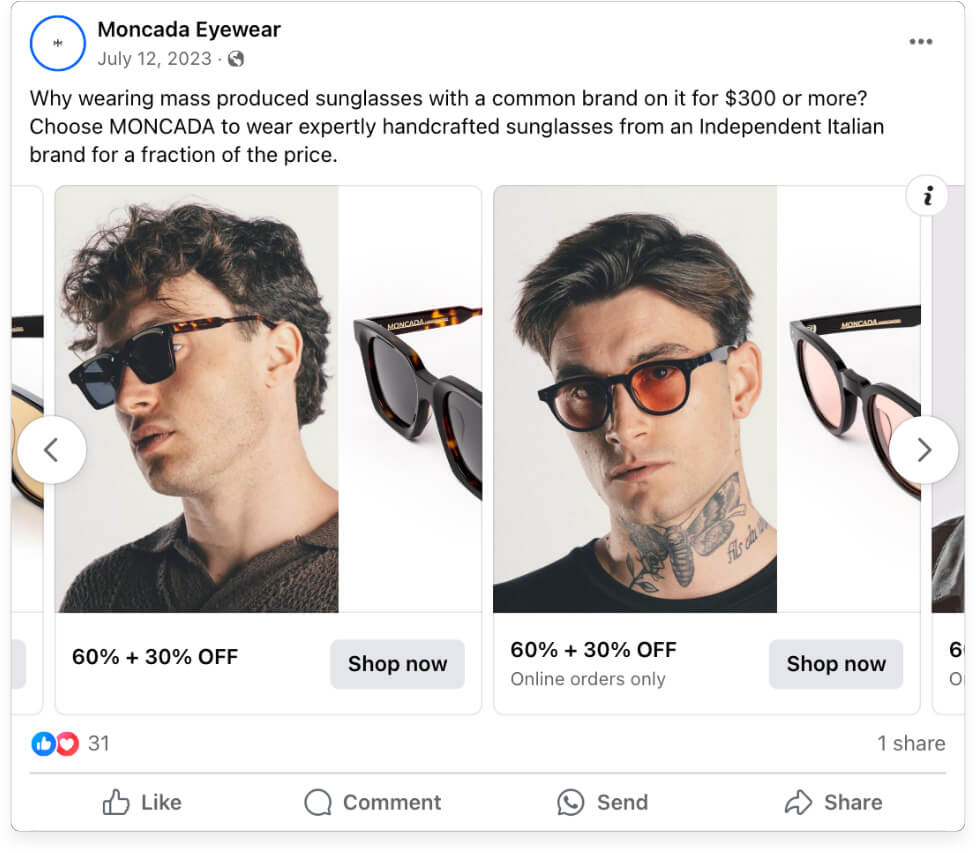
The Catalog Ad above from Moncada is a good example of showing multiple images of the same product, in this case, the glasses as a packshot and on a model.
Here's how showing additional images on average influence Catalog Ads:
Return On Ad Spend
-1%
Cost Per Purchase
-4%
Click Through Rate
+10%
Cost Per Click
+2%
Conversion Rate
-7%
Usage
32%
These numbers show how Catalog Ads showing additional images perform on average compared to Catalog Ads not showing additional images.
Remember that these are average numbers. For some brands, additional images perform better, and for other brands, additional images perform worse.
When you introduce your products for consumers for the first time, you should not reveal too much information about the product. Don’t overwhelm a curios consumer with too many details - you can always do this later.
Additional images of the product is adding more details, in a visual way - and what we see, is that the lower in your funnel the consumer is, the better additional images work.
- Top-funnel ads see a +7% improvement in Return on Ad Spend when showing additional images
- Bottom-funnel ads see a +33% improvement in Return on Ad Spend when showing additional images
You can learn more about showing additional images in your Catalog Ads here.
Advantages of showing additional images:
- Shows product in multiple contexts or angles.
- Helps customers visualize product usage and benefits.
- Provides additional information that text alone cannot convey.
Disadvantages of showing additional images:
- Can clutter the design and remove focus from other information like price.
- An overload of images might confuse or distract the buyer.
- Can be redundant if the main product image is already clear.
If you’re interested, we have more information and examples on showing additional images in your Catalog Ads, plus tips on how to do it with Confect right here.
Showing Savings and Discounts in your Catalog Ads
29% of all advertisers designing their Catalog Ads with Confect show the saving of the product.
Savings and discounts can be shown both in percentages (40% off) or in monetary values (save $150), and is only shown if the product is discounted.
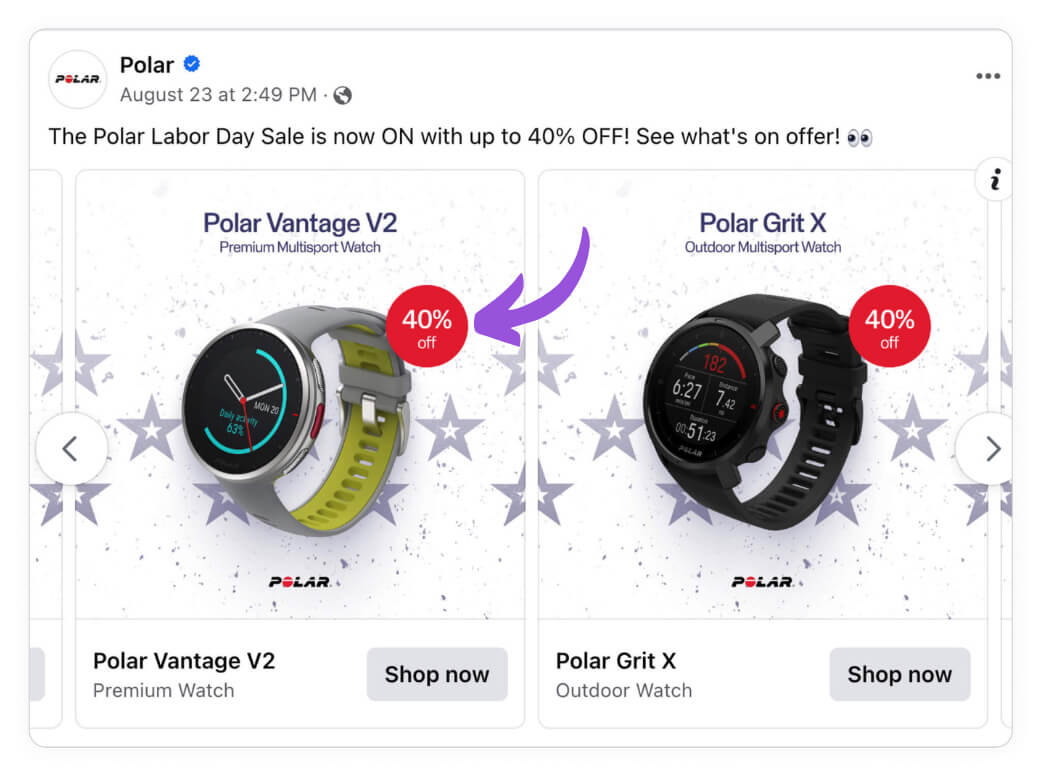
The Catalog Ad above from Polar is a good example of highlighting savings and discounts in a very visible way.
Here's how showing savings on average influence Catalog Ads:
Return On Ad Spend
+57%
Cost Per Purchase
-14%
Click Through Rate
+2%
Cost Per Click
-18%
Conversion Rate
+5%
Usage
29%
These numbers show how Catalog Ads showing savings perform on average compared to Catalog Ads not showing savings.
Remember that these are average numbers. For some brands, savings perform better, and for other brands, savings perform worse.
The more affordable prices you have, the better savings and discounts typically perform in your Catalog Ads.
- Affordable shops see a +115% improvement in Return on Ad Spend when showing savings and discounts
- Mid-end shops see a +73% improvement in Return on Ad Spend when showing savings and discounts
- High-end/ Luxury shops see a +24% improvement in Return on Ad Spend when showing savings and discounts
You can learn more about showing savings during campaigns in your Catalog Ads right here and see a lot of sales and campaign Catalog Ad examples here.
Advantages of showing savings:
- Drives urgency with limited-time discounts.
- Encourages impulse purchases.
- Simplifies decision-making by emphasizing cost-effectiveness.
Disadvantages of showing savings:
- Encourages bargain-hunting over brand loyalty.
- Can lower performance for products not on sale.
- Can lead to lower profit margins.
Savings and discounts are almost always good ways to make people buy, but it's interesting how they are a bit more effective for the brands themselves than for multi-brand stores.
- Brands and DTC companies see a +73% improvement in Return on Ad Spend when showing savings and discounts
- Multi-brand stores see a +54% improvement in Return on Ad Spend when showing savings and discounts
If you’re interested, we have more information and examples on showing savings and discounts in your Catalog Ads, plus tips on how to do it with Confect right here.
Showing Dates in your Catalog Ads
22% of all advertisers designing their Catalog Ads with Confect show dates, days, weeks, or months in the ads.
This can be specific dates (if a sale is ending), promotional weeks (cyber week), special days like Valentine's Day, or alike.
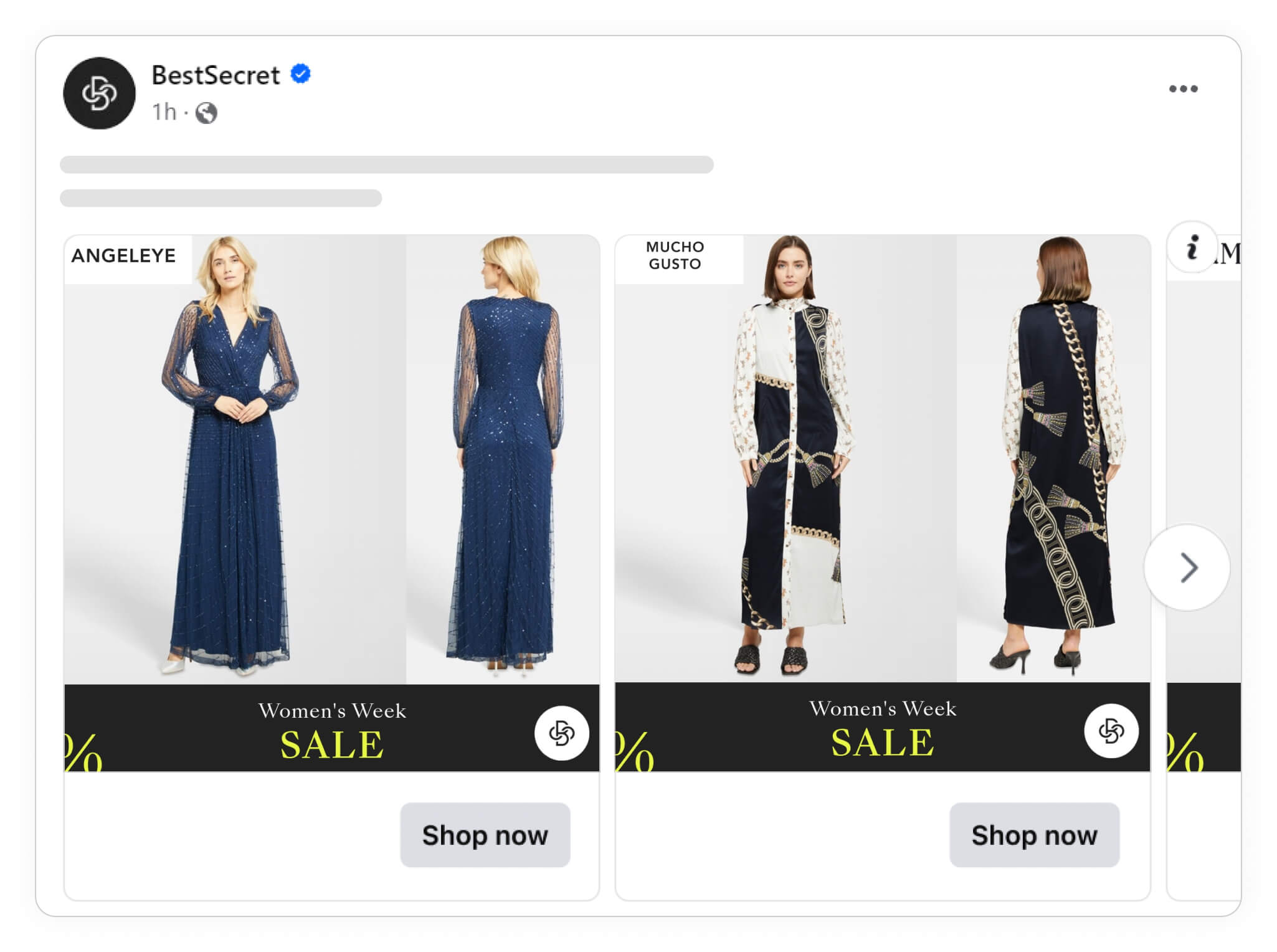
The Catalog Ad above from BestSecret is a good example of creating urgency with a custom promotion, in this case their Women's Week Sale.
Here's how showing dates on average influence Catalog Ads:
Return On Ad Spend
+14%
Cost Per Purchase
-16%
Click Through Rate
-6%
Cost Per Click
+13%
Conversion Rate
+9%
Usage
22%
These numbers show how Catalog Ads showing dates perform on average compared to Catalog Ads not showing dates.
Remember that these are average numbers. For some brands, dates perform better, and for other brands, dates perform worse.
Dates are especially effective for multi-brand stores.
- Brands and DTC companies, on average, don't see improvements in Return on Ad Spend when showing dates
- Multi-brand stores see a +49% improvement in Return on Ad Spend when showing dates
Advantages of showing dates:
- Differentiates seasonal events from year-round offerings.
- Encourages immediate action.
- Creates urgency with limited-time offers.
Disadvantages of showing dates:
- Adds clutter to the design if not used strategically.
- Can distract from other product features.
- Might not be suitable for luxury or high-end brands.
Highlighting News in your Catalog Ads
20% of all advertisers designing their Catalog Ads with Confect highlight new products in one way or another.
This can be highlighted in multiple ways, from showing small labels like "new in" or "just arrived", to whole designs made only for newly arrived products.

The Catalog Ad above from Foberry is a good example of highlighting news in a classy and exclusive way.
Here's how highlighting news on average influence Catalog Ads:
Return On Ad Spend
-5%
Cost Per Purchase
-18%
Click Through Rate
+5%
Cost Per Click
-26%
Conversion Rate
-26%
Usage
20%
These numbers show how Catalog Ads highlighting news perform on average compared to Catalog Ads not highlighting news.
Remember that these are average numbers. For some brands, highlighting news perform better, and for other brands, highlighting news perform worse.
Advantages of highlighting new products:
- Highlights fresh inventory, driving curiosity.
- Appeals to early adopters, nerds, and trend-seekers.
- Works well in fast-moving industries like fashion.
Disadvantages of highlighting new products:
- Can overwhelm customers with too many labels and information.
- May reduce interest in older products.
- May lower performance if the product is unknown or untested.
If you’re interested, we have more information and examples on highlighting new products in your Catalog Ads, plus tips on how to do it with Confect right here.
Showing Shipping info in your Catalog Ads
17% of all advertisers designing their Catalog Ads with Confect show information about their shipping policies.
This can be done in multiple ways by showing shipping time, whether you have free shipping or not, return policies, and alike.

The Catalog Ad above from Nike is a good example of highlighting shipping information in a subtle way - making the decision whether to buy or not easier with free shipping and returns.
Here's how showing shipping info on average influence Catalog Ads:
Return On Ad Spend
-2%
Cost Per Purchase
-27%
Click Through Rate
-1%
Cost Per Click
-18%
Conversion Rate
-16%
Usage
17%
These numbers show how Catalog Ads showing shipping information perform on average compared to Catalog Ads not showing shipping information.
Remember that these are average numbers. For some brands, shipping info perform better, and for other brands, shipping info perform worse.
It is rare to see shipping information improving the performance of Catalog Ads, but when looking at shop types, we actually see a big difference:
Customers don’t care about shipping information from brands themselves, whereas multi-brand stores might benefit from telling customers in the ads directly.
Brands and DTC companies should talk more about themselves and their products, not about shipping information, which is likely the same for other brands.
- Brands and DTC companies see a -38% decrease in Return on Ad Spend when showing shipping information
- Multi-brand stores see a +11% improvement in Return on Ad Spend when showing savings and discounts
Advantages of showing shipping info:
- Attracts buyers with free or fast shipping offers.
- Reduces hesitancy by clarifying shipping details upfront.
- Simplifies decision-making with transparent shipping policies.
Disadvantages of showing shipping info:
- Potentially overemphasizes logistical details over product quality.
- Could add unnecessary complexity or decisions upfront.
- Might be repeated multiple times in the same ad.
Using Product Assets in your Catalog Ads
12% of all advertisers designing their Catalog Ads with Confect show visual information about the product via Product Assets.
Product Assets can be used to visually show information like brand logos, showing ratings with icons like stars or hearts, visually highlight features like Gore-Tex or Organic products, and alike.
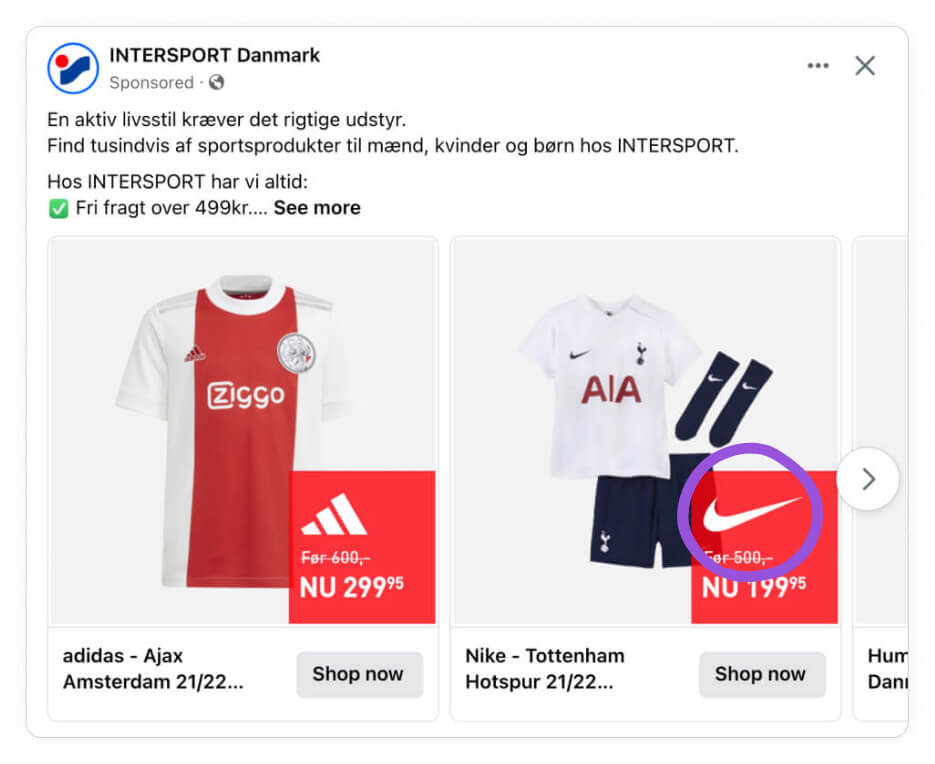
The Catalog Ad above from Intersport is a good example of using Product Assets to show the brand logo in a visual way - making the brands easier to recognize.
Here's how showing product assets on average influence Catalog Ads:
Return On Ad Spend
+80%
Cost Per Purchase
-33%
Click Through Rate
+8%
Cost Per Click
-12%
Conversion Rate
+23%
Usage
12%
These numbers show how Catalog Ads showing product assets perform on average compared to Catalog Ads not showing product assets.
Remember that these are average numbers. For some brands, product assets perform better, and for other brands, product assets perform worse.
Product Assets are especially effective for mid-end shops that don't rely on luxury products or very affordable products.
- Affordable shops see a +12% improvement in Return on Ad Spend when showing Product Assets
- Mid-end shops see a +75% improvement in Return on Ad Spend when showing Product Assets
- High-end/ Luxury shops see a -17% decline in Return on Ad Spend on average when showing Product Assets
You can learn more about using Product Assets in your Catalog Ads here.
Advantages of showing product assets:
- Adds visual clarity with logos, icons or images.
- Highlights important product information visually.
- Creates a more engaging and professional ad.
Disadvantages of showing product assets:
- Could clutter the ad with too many elements.
- May distract from the core message of the ad.
- Could confuse customers if too many visual cues are used.
If you’re interested, we have more information and examples on showing product assets in your Catalog Ads, plus tips on how to do it with Confect right here.
Showing Social Proof in your Catalog Ads
11% of all advertisers designing their Catalog Ads with Confect show some kind of social proof.
This can be done in various ways, either by showing ratings of the product, awards won, reviews from external providers like Trustpilot, showing bestsellers or "popular" badges, and alike.
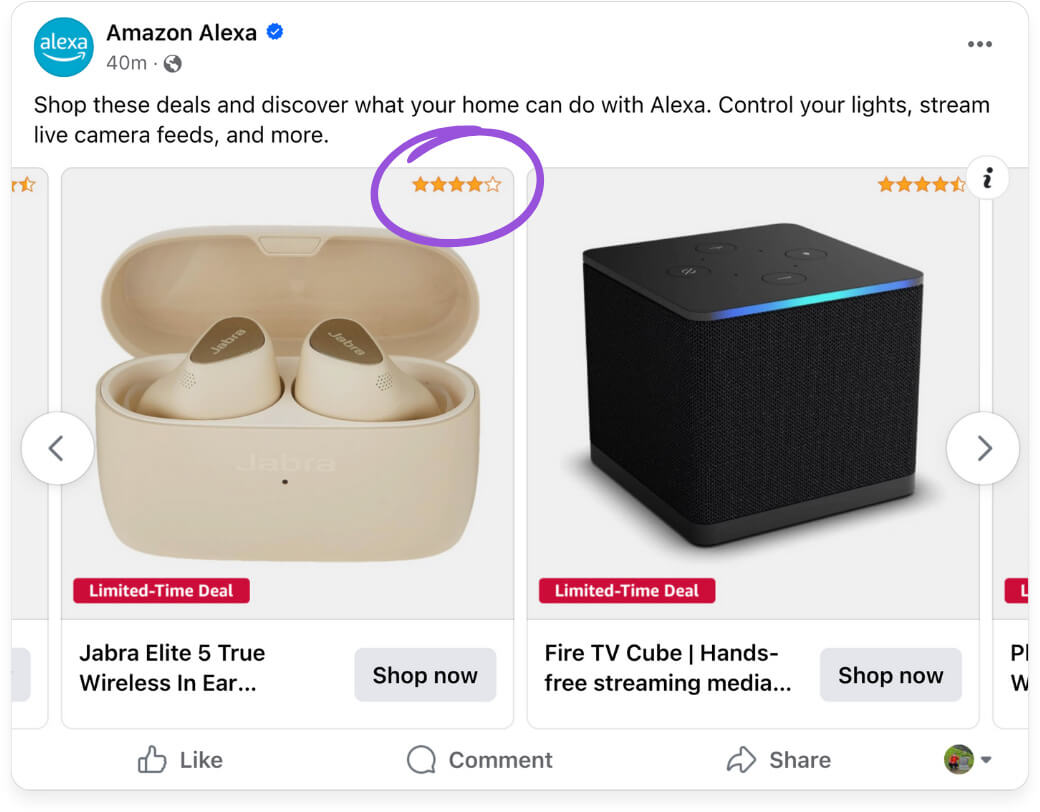
The Catalog Ad above from Amazon is a good example of highlighting social proof via their ratings - making it less risky to buy the products; now, other people have rated this product well.
Here's how showing social proof on average influence Catalog Ads:
Return On Ad Spend
+31%
Cost Per Purchase
-1%
Click Through Rate
-22%
Cost Per Click
+19%
Conversion Rate
+46%
Usage
11%
These numbers show how Catalog Ads showing social proof perform on average compared to Catalog Ads not showing social proof.
Remember that these are average numbers. For some brands, social proof perform better, and for other brands, social proof perform worse.
The lower price levels you have compared to competitors, the better showing Social Proof will typically perform.
- Affordable shops see a +72% improvement in Return on Ad Spend when showing Social proof
- Mid-end shops see a +32% improvement in Return on Ad Spend when showing Social Proof
- High-end/ Luxury shops see a +10% improvement in Return on Ad Spend when showing Social PRoof
You can learn more about showing Social Proof in Catalog Ads here.
Advantages of showing social proof:
- Increases trust and social validation.
- Boosts perceived value of the product or brand.
- Helps mitigate product hesitancy.
Disadvantages of showing social proof:
- Could clutter ad design with too much information.
- Might be repeated multiple times in the same ad.
- May backfire if reviews are negative.
If you’re interested, we have more information and examples on showing social proof in your Catalog Ads, plus tips on how to do it with Confect right here.
Especially customers who don't know you or your products find a lot of trust in your social proof - the earlier in your marketing funnel customers are, the more effective Social Proof is.
- Top-funnel ads see a +58% improvement in Return on Ad Spend when showing Social Proof
- Bottom-funnel ads see a +35% improvement in Return on Ad Spend when showing Social Proof
Showing Product Brands in your Catalog Ads
10% of all advertisers designing their Catalog Ads with Confect show the brand of the product.
This can either be in written text, or by showing the logo of the brand.
.jpg)
The Catalog Ad above from Zalando is a good example of highlighting the brand of the product very clearly.
Here's how showing brand names on average influence Catalog Ads:
Return On Ad Spend
+44%
Cost Per Purchase
+11%
Click Through Rate
+22%
Cost Per Click
-34%
Conversion Rate
-13%
Usage
10%
These numbers show how Catalog Ads showing brand names perform on average compared to Catalog Ads not showing brand names.
Remember that these are average numbers. For some retailers, brand names perform better, and for other retailers, brand names perform worse.
The more high-end and expensive your products are, the better performance you will typically see when showing the brands of your products.
- Affordable shops see a +13% improvement in Return on Ad Spend when showing brands
- Mid-end shops see a +29% improvement in Return on Ad Spend when showing brands
- High-end/ Luxury shops see a +62% improvement in Return on Ad Spend when showing brands
You can learn more about showing brand names or brand logos in your Catalog Ads here.
Advantages of showing product brands:
- Appeals to customers who are loyal to specific brands.
- Works well for products where brand identity is crucial, like fashion or electronics.
- Increases trust by showing a reputable brand.
- Simplifies decision-making for brand-conscious shoppers.
Disadvantages of showing product brands:
- Can overshadow product features or pricing.
- May confuse customers if brand logos or names are unfamiliar.
- Might make the buying journey longer when introducing brands as a factor.
If you’re interested, we have more information and examples on showing brands in your Catalog Ads, plus tips on how to do it with Confect right here.
Showing Custom_labels in your Catalog Ads
8% of all advertisers designing their Catalog Ads with Confect show one or more custom_labels with custom information about the product.
This can be features about the product, meta information like "outlet", "deal", or "new arrival", and various other things.

The Catalog Ad above from Canada Goose is a good example of using custom information via custom_labels, in this case which temperatures the product is built for.
Here's how showing custom labels on average influence Catalog Ads:
Return On Ad Spend
+37%
Cost Per Purchase
+4%
Click Through Rate
-10%
Cost Per Click
-21%
Conversion Rate
-13%
Usage
8%
These numbers show how Catalog Ads showing custom labels perform on average compared to Catalog Ads not showing custom labels.
Remember that these are average numbers. For some brands, custom labels perform better, and for other brands, custom labels perform worse.
The more consumers learn about you and your products, the more nerdy they typically want to become - and we see this very clearly when looking at Custom_labels, the best way to show custom information in Catalog Ads.
The further down you are in your marketing funnel, the better nerdy and custom information will perform.
- Top-funnel ads see a +29% improvement in Return on Ad Spend when showing Custom labels
- Bottom-funnel ads see a +73% improvement in Return on Ad Spend when showing Custom labels
Advantages of showing custom_labels:
- Differentiates products within the same category or industry.
- Ideal for highlighting exclusivity or unique features.
- Might be your most valuable information your customers are looking for.
Disadvantages of showing custom_labels:
- May clutter ad design with excessive information.
- Could confuse users if the custom label isn’t clear.
- Less effective if labels are too niche or irrelevant.
If you’re interested, we have more information and examples on showing features and custom_labels in your Catalog Ads, plus tips on how to do it with Confect right here.
Showing Categories in your Catalog Ads
3% of all advertisers designing their Catalog Ads with Confect show the category of the product.

The Catalog Ad above from Cashmirino is a good example of showing categories in a subtle way, to make sure customers know which product they are looking at in the ad (whether it's the shirt or the pants).
Here's how showing product categories on average influence Catalog Ads:
Return On Ad Spend
+64%
Cost Per Purchase
-51%
Click Through Rate
+3%
Cost Per Click
-23%
Conversion Rate
+48%
Usage
3%
These numbers show how Catalog Ads showing categories perform on average compared to Catalog Ads not showing categories.
Remember that these are average numbers. For some brands, categories perform better, and for other brands, categories perform worse.
Advantages of showing product category:
- Helps users quickly identify product types.
- Helps users understand what a product is.
- Strengthens retargeting by focusing on category interests.
Disadvantages of showing product category:
- May reduce focus on individual product features.
- Not impactful if the category of the product is clear.
- May clutter the ad with too much (irrelevant) information.
Showing Product Descriptions in Catalog Ads
1% of all advertisers designing their Catalog Ads with Confect show parts of the description of the product.
This can either be the full description, or just parts of the product description like the first sentence or two.
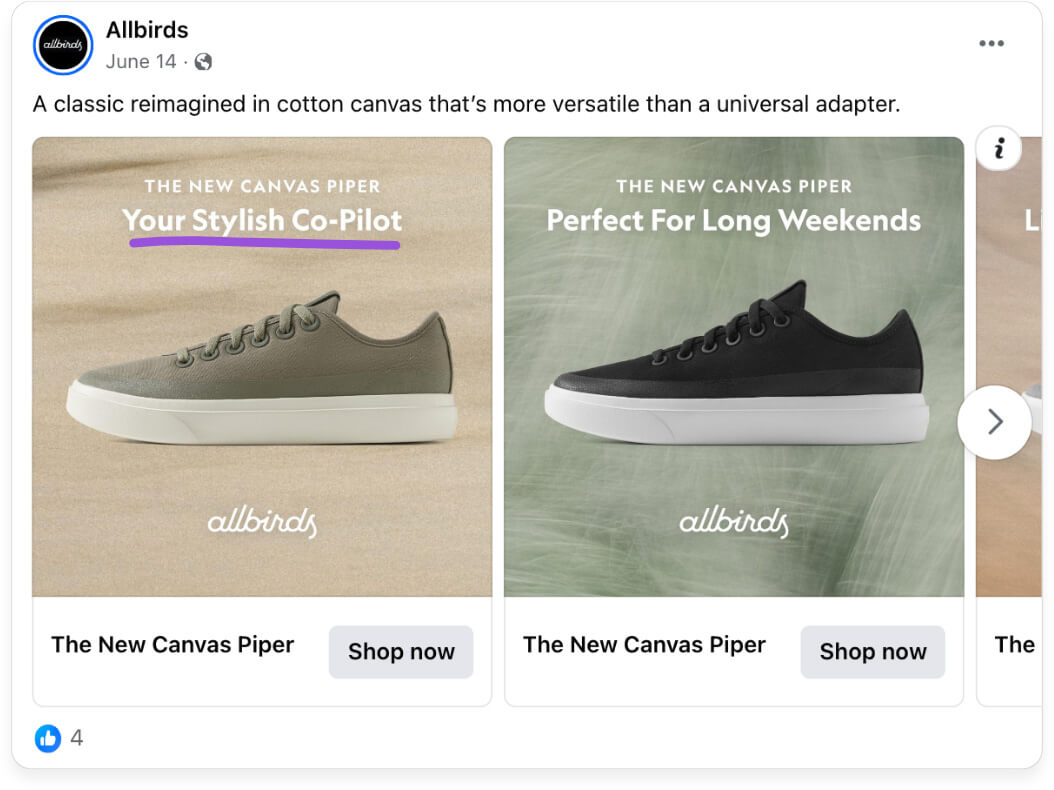
The Catalog Ad above from Allbirds is a good example of showing a small part of the product description to highlight the benefit of the product.
Here's how showing descriptions on average influence Catalog Ads:
Return On Ad Spend
+47%
Cost Per Purchase
-8%
Click Through Rate
-22%
Cost Per Click
+17%
Conversion Rate
-17%
Usage
1%
These numbers show how Catalog Ads showing descriptions perform on average compared to Catalog Ads not showing descriptions.
Remember that these are average numbers. For some brands, descriptions perform better, and for other brands, descriptions perform worse.
Advantages of showing product descriptions:
- Provides more product information for in-depth understanding.
- Helps clarify unique product features.
- Differentiates from competitors with vague or minimal descriptions.
Disadvantages of showing product descriptions:
- Could clutter the ad with too much text.
- May reduce the focus on visuals or pricing.
- Your descriptions might be too long.
Bookmark this page by pressing ctrl + D / cmd + D, or by clicking the star icon in your URL bar ⭐️.
Information about the study, for the nerds:
Data is based on 6.5 billion impressions and $30.8 million in ad spend from December 2023 to September 2024.
Data is across 568 ecommerce advertisers all over the world, in different industries, using 3k different designs in the time period.
All the Catalog Ads in the study were designed with Confect.
